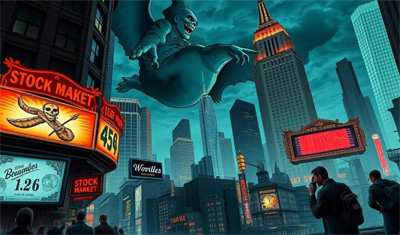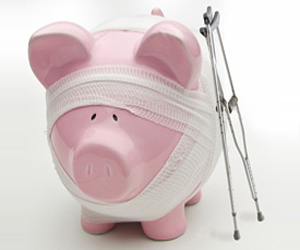Stock Market Trembles with Deep Fear over Inflation and Job News
David Haggith
 No small changes in the news today, but deep troubles rumbling up toward the surface from times past that will easily be made worse by times coming. No small changes in the news today, but deep troubles rumbling up toward the surface from times past that will easily be made worse by times coming.
The Dow tumbled, Warren Buffet fled the S&P500 stocks he had been advocating, and the Nasdaq fell off a cliff today. Plunging by more than 500 points, the Nasdaq pulled an equivalent of a thousand-point drop in the Dow.
The reasons for what Zero Hedge called “market chaos” were two-fold: Inflation is clearly heating up again, as forecast consistently here all of last year for the end of last year but especially this year, and jobless claims jumped upward.
Inflation fears are frantic now
The fear from rising inflation strikes deep … like muscle memories or like post-traumatic stress syndrome for those who thought they were coming home from a war, only to find they’re headed right back. However, inflation fear has a new deep resonance that is more like primordial or mythical memories that it is taking on now. By that, I mean some kind of deep programmed memory that has become wired into the human sense of horror from before the individual feeling that sensation was even born. It is like instinct in animals—things an individual animal knows it must do, having never before had to do it in that animal’s lifetime.
Modern man has felt this before, but it exists only in stories for many living today. The inflation news that hit hard today was a big call-out about egg prices that have gone berserk and now beef prices. Before that, it was cacao prices. None of these have anything to do with the Trump Tariffs because the tariffs haven’t even been implemented yet. This is, to some extent, the inflation I said all of last year you could expect to see rising again, but it is also not even entirely that.
Inflation in these commodities is anomalous to all of of the other inflation because it is due to egg shortages from all the chickens that the Biden government mandated killing (or that some farmers may have chosen to kill in concern of bird flu spreading) and due to beef shortages that are finally playing through from the first round of inflation that came with the Covid lockdowns and the Ukraine war, which set feed prices on fire so that ranchers seriously reduced their herds back then because they could not make enough to cover the cost of feeding them as well as not make enough to cover other rising costs from general inflation.
That earlier reduction of the herds included a reduction in breeding cows, and that is now showing up as beef shortages. As these things always go, the shortages then drive the price of beef up to where farmers and ranchers can now make a big profit off of beef, except that it will take them about two years to rebuild their herds in order to sell into those prices. So, until then, the beef shortages continue with prices likely to rise even more. The egg shortage will continue, too, as avian flu is not apparently done with the chicken business yet. Maybe not ever. So, those prices will remain high or rise more.
None of that can be blamed on the Trump Tariffs. However, it sets a good example of the high-inflation environment that I have been saying makes this time so different than the last time tariffs were imposed. People still have enough money that, when shortages hit, they start bidding up the price of beef or eggs to get what they want. So far, beef and eggs, at much higher prices are having no problem selling out. That will be true of other things that experience shortages due to tariff-related supply-chain problems until the money runs out.
This is the environment in which tariff-based inflation is now going to pile on. It is what makes tariffs much more problematic this time than last. We are already in a rising inflation environment, so inflation readily bursts back into flames if given any oxygen or additional fuel.
The big risk I’ve been laying out is that tariffs get added to prices as part of the cost of good’s sold, but tariffs, as we saw in Trump’s first term, also create supply-chain crises that cause shortages. With those two factors piling onto the rising background of inflation in most prices that we now feel all around us, those additional shortages will do to other prices what egg and beef and cocoa shortages have done to prices in those commodities.
If the Fed tries its usual money-printing tricks to ward off a recession in an environment where the worsening of inflation is already being felt, after the Trump Tariffs start to add new heat to the existing fire by creating shortages, we could see all prices rising at the rate beef and egg prices have climbed, which would mean to levels above where they went in the first round of inflation. That would be because the Fed is not letting the money run out, so it keeps driving inflation higher.
If Trump also does as he and Elon talked about again today in the news, and gives DOGE paybacks to the public, that will add even more fuel to the fires of inflation. Right now, none of the inflation in today’s news has much to do with Trump, yet it’s already heating up to where people are inflamed about it.
(Bloomberg) — No matter what metric you’re looking at, US inflation is moving in the wrong direction again.
Whether it’s a house or a carton of eggs, price growth is once again intensifying across a broad range of indicators. Much of that has to do with the same supply and demand factors and labor-market pressures that led to the initial inflation surge in the pandemic, while planned tariffs from President Donald Trump are heightening concerns that prices will rise even more.
That is exactly what I started warning about this year. Its not surprising that all of this felt fear about inflation has caused consumer predictions of future inflation to rise to the worst levels ever seen, and that can become its own self-fulfilling prophecy:
That reading says it’s the highest consumers have feared in thirty years, but other stories have referred to it as the highest in as long as this metric has been measured.
The scope of reports indicating a resurgence in price pressures — spanning from input costs to wage growth to inflation expectations — underscores the Federal Reserve’s intent to keep interest rates on hold for the time being. Policymakers’ preferred gauge of underlying inflation probably picked up in January, ahead of data due Friday.
We’ll see what those data reveal on Friday, and I may add that to my weekend Deeper Dive in which I will also expand on the job metrics covered briefly below:
Our outlook is very much for inflation to be coming back. We’ve been saying second half of this year, but it seems like the pressures are already starting to build,” said Lauren Saidel-Baker, economist at ITR Economics.
They’re late in joining me in that proclamation; but, at least, economists are seeing it and saying it at last.
And between the administration’s policies on tariffs and immigration, there’s more to come, she said. “I want to be absolutely clear: there are upside risks to our inflation outlook.”
There are serious upside risks: Factory input costs are their highest in two years (going back to when we were just recovering from the supply-line crises of Covid lockdowns). Lumber and steel have been high since the pandemic, and are going up even more. The Dallas Fed reported index prices for raw materials has doubled to match where they were when consumer inflation hit its last peak. All of that has to get passed on yet. Housing prices are still getting worse on average across the US, even as pending sales have absolutely crashed in today’s news due to high prices. (All depending on the region, of course, but as a national average, that is where we are.)
So, there is a lot of price pressure built up in the pipeline now from all that time over which I’ve been reporting to you that these upstream pressures would keep increasing until they burst into consumer prices.
Job losses piling on
On top of that inflation news, we got today’s labor-market news, which was worse than expected. The stock market’s fear exhibited today, especially in the Nasdaq, coupled those inflationary stories with rising angst over suddenly rising joblessness because that indicates a recession is rising insidiously inside of this time of pressurizing inflation.
That, in turn means the Fed will be caught right where I’ve always said this winds up—not being able to intervene to help us out of a recession or to bid up falling stocks. In the very least, it will be highly reluctant to do so and will find it hard to do so—because all inflation will start looking like that extra-high beef, egg, and chocolate inflation we’ve been seeing where inflation is on a tear because of shortages.
The Fed knows the public will be outraged if the Fed lets inflation go skyrocketing all over again, so we have to start the inflation battle afresh. They are already starting to express outrage about these beef, egg and chocolate prices, and those are nothing compared to what could be coming when tariffs hit, depending on what actually gets implemented. Yet, that was the other news today: Trump underscored that the new tariffs on Mexico and Canada will come in the first week of March after all, and the new Chinese tariffs right behind them, as already scheduled, and said then he plans tariffs on just about everything else, which are yet to be figured out.
Today’s underlying fear is that layoffs suddenly rose before Trump’s government firings have even had time to process. One has to be unemployed for a full week before he or she can even apply for unemployment in most states. Then it takes a week for state unemployment agencies to process those applications and time to send out checks, and may take longer than that for those to get reported to the government. Yet, the numbers are already starting to rise.
I didn’t expect to see much action until the first week of March; so, there is a deep sense that the ground is quaking like gelatin in ways that say things are not well below. Like a deep bass rumble you feel in your chest and your brain, but that is so low you can’t quite hear it, today’s rising jobless rate rattled hearts in the stock market with fear.
As with inflation and tariffs, it is really too early for Trump’s government cuts to be showing up much in the data, but that could be what today’s rise was. We may see a clearer picture in Friday’s jobs reports. If the rise in new jobless claims is not due to the Trump government cuts—though it probably is just the very earlier numbers coming through—that is even worse because that means this is simply the existing shaky job environment into which those cuts will be dumping directly in all the weeks ahead.
There is a very good video interview in the headlines below that adds up the real numbers regarding the job cuts and shows how you get to where these cuts can rapidly become a severe problem, in spite of their relatively small numbers as a portion of the total labor market. (Right now Trump has moved from promising 220,000 government job cuts to 300,000.) It’s not a guarantee that those numbers will blow out to over a million jobs lost, but the person interviewed lays out a very conservative case as to how the knock-on effects CAN easily happen as chain reaction that is much like I laid out in my last Deeper Dive, but even more intense.
So, I’ll look at what comes in Friday for jobs, combine it with the case made for where the Trump job cuts may go and why they would or would not go there and lay that out in my Deeper Dive along with any additional information that comes in about soaring inflation.
Oh Canada
And then there is the damage from Trump’s imperial claims over Canada that will be adding recessionary forces to the US economy by cutting down our exports to Canada without even applying tariffs. News today is of how quickly a general citizen’s boycott of “all things made in the USA” is spreading through Canada out of sheer disgust toward our nation’s new interest in taking over Canada and adding it to the empire.
Turns out almost no Canadians are so envious of US citizens, as some American’s have believed, that they covet the chance to become one of us. This is the old “Freedom Fries” response we saw among Americans but on steroids as talk of taking over another nation is infinitely worse than what was at stake back when the French merely refused to help us take over Iraq or, at least, oust Saddam.
Canada is a large market for the US, and Canadians are rapidly starting to shun all US products because our president wants to rule them and has implied he will use tariffs to strong-arm them into joining us. Canadians said, “Heck with tariffs. We’ll just boycott you completely.” Turns out talk of forced annexation is, to Canadians, like hearing your generally friendly in-laws have decided to move in on you for good, only they are also claiming permanent ownership of your house, though they will kindly let you continue to live in it with them.
You can also enjoy the video Trump reportedly just posted on his own Truth Social account of his new imperial plans for Gaza at this link. It’s truly strange with its image of what truly looks like a golden idol of Trump over Gaza.
Times so strange you can hardly make them sound as strange as they are.
Share
This post is for paid subscribers

Economic, Social and Political News of Our Troubled Times -- a non-partisan daily collection of the most consequential stories about our complex times from multiple sources around the world.
www.thedailydoom.com
| 

